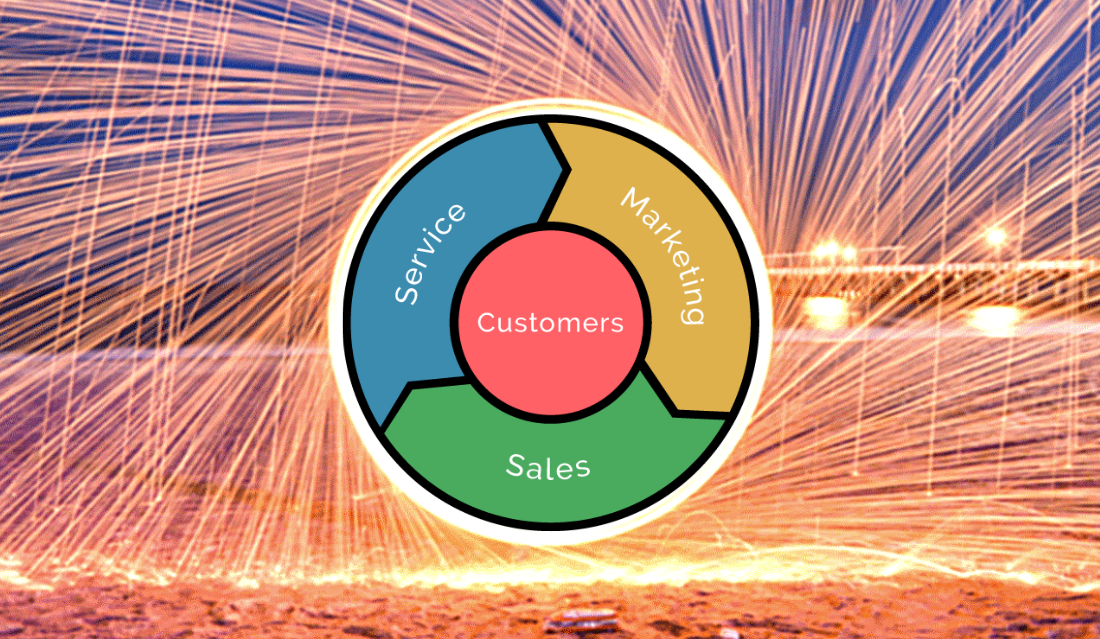Marketing In Real-Time: Digital in Overdrive
In an increasingly hyper-connected world, real-time marketing has an air of inevitability about it. Consumers in increasing numbers expect...
3 min read
Mark Parent
August 5, 2020 10:31:45 AM EDT

For years, companies have structured their business strategies around the linear sales funnel — and it worked.
But recently, the funnel has begun to fail marketers, salespeople, and business leaders alike. The funnel has one major flaw: It views customers as an afterthought, not a driving force.
Today, customer referrals and word-of-mouth have become the largest influence on the purchase process. A more organic, perpetual model is needed.
That’s where the flywheel comes in.
Want to learn more about the flywheel? Download our informative eguide.
In engineering, the flywheel is remarkable at storing and releasing energy. Turns out, that’s pretty important when thinking about your business strategy.
Invented by James Watt, the flywheel is simply a wheel that’s incredibly energy-efficient. The amount of energy it stores depends on how fast it spins, the amount of friction it encounters, and its size.
This energy is especially helpful when thinking about how customers can help your business grow.
With the flywheel, you use the momentum of your happy customers to drive referrals and repeat sales. Basically, your business keeps spinning.
When you think about your business as a flywheel instead of a funnel, you make different decisions and adjust your strategy. To show you what we mean, let us first explain how the flywheel works.
The amount of energy, or momentum, your flywheel contains depends on three things:
The most successful companies adjust their business strategies to address all three of these factors. The speed of the flywheel increases when you add force to areas that have the biggest impact — like your customer service team. By focusing on how you can make your customers successful, they’re more likely to relay their success to potential customers.
When applying force to your flywheel, you also need to make sure nothing is opposing it — that means eliminating friction from your business strategy.
You can reduce friction by looking at how your teams are structured, why customers are churning, and where prospects are getting stuck in the buyer’s journey. Are all your teams aligned or are they operating in silos? Is your pricing straightforward or is it cluttered with confusing fees? Do you allow prospects to connect with you how, when, and where they want or are they forced to follow your strict process?
The more you increase speed and decrease friction, the more you will create promoters of your business. And all those promoters make for one big flywheel.
How does the inbound methodology fit into all of this?
The inbound methodology is a circle. It focuses on how to build a flywheel that attracts, engages, and delights — creating an inbound business that puts customers first. Using the inbound methodology, you align all of your teams so they can attract, engage, and delight. You do this by applying more force and reducing friction to your flywheel and providing an amazing experience throughout the entire customer journey.
Companies that choose to use the flywheel model over the typical funnel have a huge advantage because they aren’t the only ones helping their business grow — their customers are helping them grow as well.
That’s a much more efficient way to attract new customers and retain existing ones.
The flywheel also helps eliminate friction and reduce clumsy handoffs between teams. In the funnel model, customers are often shuffled from marketing to sales to customer service. This can lead to a pretty unpleasant customer experience.
But with the flywheel model, the onus is on every team in the entire company to attract, engage, and delight customers. When all of your teams are aligned around the inbound methodology, you can provide a more holistic, delightful experience to anyone who interacts with your business.
The flywheel model is a more comprehensive, unified way of representing the forces affecting your company’s growth.
he actions taken by each team at your company impact each other. Your marketing inputs affect how quickly prospects move through your sales process. Your sales motion affects how likely it is prospects will become happy and successful customers. And of course, your support and service activities impact whether your customers become promoters — people who recommend you to their colleagues — or warn their networks to stay away.
Conversations happen in more places, among more people, than ever before. The funnel was a good representation of how buyers used to learn about products — they found (or were sent) marketing materials, they had to speak to salespeople to find out more information, and then they became customers.
But that’s not how people make decisions today. They ask their networks for advice, they search for mentions of your company on social media, and you bet they’re reading third-party review sites.
The traditional funnel doesn’t account for any of these factors. And because they’re linear, funnels don’t reveal the momentum you build through a great product and customer experience, nor the drag you experience when your processes start to slow down growth.
Simply put, the flywheel is a more comprehensive look at where your business is growing fastest, and it reveals your biggest areas of opportunity.
That's why companies need to put their customers first and do more than just grow — they need to grow better. Growing better is applying force to the strongest areas of your business and eliminating any friction that gets in the way — especially if it has a negative impact on your customers.
If your company is difficult to navigate or relies on less-than-honest tactics, don’t be surprised when people start walking out the door. But if you take the time to invest in transparent, easy-to-understand processes that truly serve your customers, you just might find yourself at the top.
This is adapted from an article originally published at HubSpot.com. Repurposed by permission.

In an increasingly hyper-connected world, real-time marketing has an air of inevitability about it. Consumers in increasing numbers expect...

As marketers, we all know the importance of marketing to the right audience, but what is segmentation targeting and positioning in a marketing plan,...

Videos are essential for brands to stand out, but success requires more than good equipment. It takes a team that understands your story and knows...